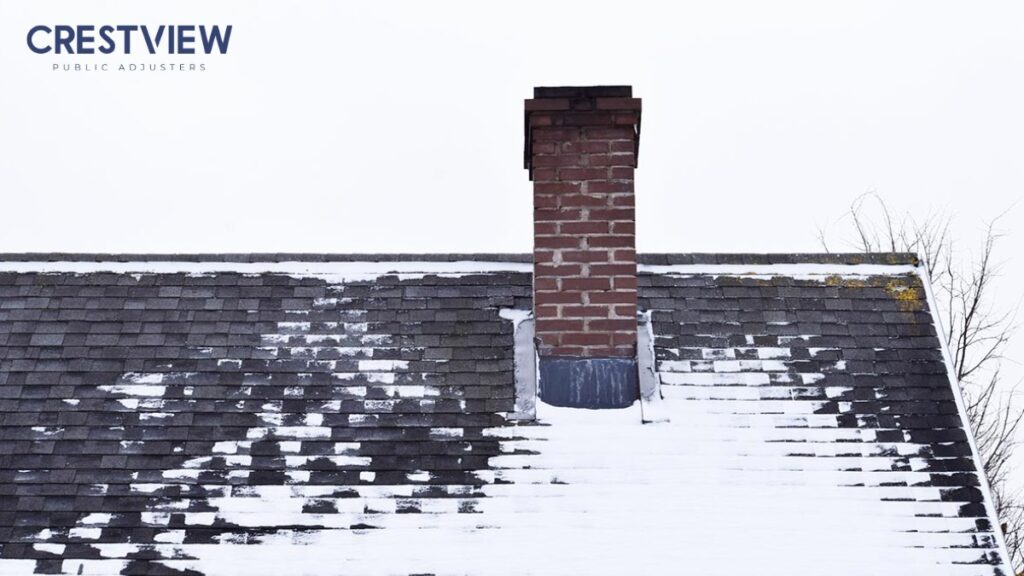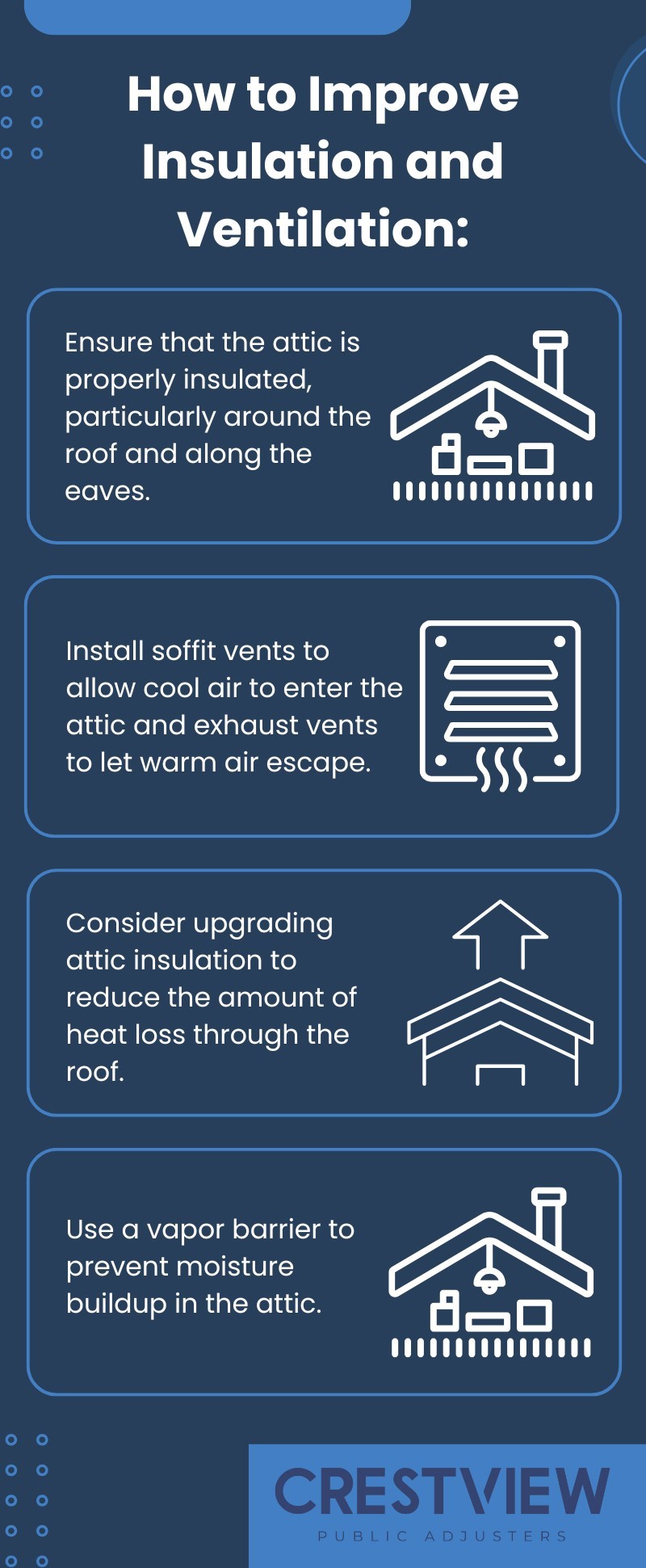Key Points:
- Leaky roofs in winter are often caused by ice dams, clogged gutters, and poor insulation.
- Ice dams form when snow melts and refreezes at the roof’s edge, creating a barrier that traps water.
- Clogged gutters, blocked by fallen leaves or debris, prevent proper drainage, causing water to seep into your roof.
- Effective insulation and proper maintenance are critical to avoiding leaky roofs in winter.
Winter can be a beautiful time of year, but it also brings specific challenges for homeowners—particularly when it comes to roof maintenance. According to the Insurance Information Institute, roof damage is one of the most common reasons for winter damage claims. As temperatures dip, snow accumulates, and ice forms, it can create the perfect storm for a leaky roof. In this article, we’ll look at some of the most common causes of a leaky roof in winter and how to address them.
What Causes a Leaky Roof in Winter?
A leaky roof in winter is often the result of a combination of weather conditions, roof conditions, and maintenance lapses. The transition from freezing to thawing temperatures creates a constant cycle of ice and water, which can cause damage if the roof isn’t properly prepared.
This phenomenon usually begins when snow accumulates on your roof. During the day, sunlight or indoor heating can cause the snow to melt, sending water down the roof. However, when the temperature drops at night, the water refreezes at the eaves, forming ice dams. These ice dams prevent the water from draining off the roof, and eventually, it backs up underneath the shingles, leading to leaks inside your home.
How Do Ice Dams Lead to Roof Leaks in Winter?
One of the most notorious causes of a leaky roof in winter is the formation of ice dams. These formations occur when snow melts on the roof, and the resulting water trickles down to the eaves where it freezes again. This can be especially problematic for homes with poor attic insulation or ventilation, as heat escaping from the home warms the roof unevenly.
When the ice dam forms, it creates a barrier that traps water on the roof. Eventually, this trapped water begins to seep underneath the shingles, leading to leaks in the roof structure. Over time, these leaks can cause significant damage to the interior of the home, including water stains on ceilings, mold growth, and even structural damage if left unchecked.
How to Prevent Ice Dams:
- Ensure proper attic insulation to prevent heat loss from the living space below.
- Install ice and water shields under the shingles, which provide an extra layer of protection against water infiltration.
- Regularly clean gutters to ensure proper drainage and prevent the accumulation of ice and debris.
- Install heated cables along the eaves to melt the ice and allow for proper drainage.
Addressing these issues, you can prevent the formation of ice dams and protect your roof from leaks during winter.

Clogged Gutters Contributing to Leaks
Clogged gutters are another leading cause of leaky roofs in winter. During the fall, leaves, twigs, and other debris often accumulate in gutters, blocking water flow. In winter, these clogged gutters can prevent melted snow from draining properly, causing water to pool and seep into the roof structure.
Water that’s unable to flow freely through gutters can back up into the roofing materials, leading to leaks inside the house. Additionally, this stagnant water can freeze, further damaging the gutters and causing ice dams to form. Homeowners who neglect gutter maintenance often find themselves facing leaky roofs when winter weather arrives.
How to Avoid Clogged Gutters:
- Clean gutters thoroughly in the fall, removing leaves and debris before winter sets in.
- Install gutter guards to reduce debris accumulation and maintain proper water flow.
- Inspect gutters regularly during winter to ensure they’re not clogged by ice or debris.
- Ensure that downspouts are clear and direct water away from the foundation.
Maintaining clear gutters can significantly reduce the risk of water pooling on the roof and prevent costly roof repairs.
Poor Insulation and Ventilation
Another common culprit of winter roof leaks is poor insulation and ventilation in the attic. In homes with inadequate insulation, heat from the interior of the house escapes into the attic, warming the roof surface and causing snow to melt. This creates the conditions necessary for ice dams to form, as we discussed earlier.
On top of that, inadequate attic ventilation can trap warm, moist air inside, causing condensation to accumulate on the roof. Over time, this moisture can seep through the roof materials, creating a leaky roof in winter. Proper insulation and ventilation are essential to maintaining the roof’s integrity and preventing leaks from forming.

Taking steps to improve attic insulation and ventilation can help reduce the likelihood of leaks caused by moisture buildup and ice dams.
How Do Roof Shingle Issues Lead to Leaks in Winter?
A roof’s shingles are its first line of defense against the elements. If the shingles are cracked, damaged, or worn, they’re more susceptible to water infiltration during winter. As snow and ice accumulate, they can find their way under damaged shingles and leak into the home. This can lead to significant water damage, especially if the problem goes unnoticed for too long.
Winter storms can also exacerbate shingle issues, with high winds lifting shingles and allowing water to enter the roof. While it’s natural for shingles to degrade over time, winter conditions can speed up the process, leading to leaks and other damage.
How to Prevent Shingle-Related Leaks:
- Inspect your roof for damaged or missing shingles before the winter months.
- Replace any worn or damaged shingles to maintain a solid protective barrier.
- Consider applying a roof sealant to vulnerable areas to provide an additional layer of protection.
- Hire a professional roofer to inspect your roof regularly for signs of damage.
Maintaining the integrity of your shingles will reduce the chances of leaks forming during winter storms.
Call Crestview for Help with Winter Roof Leaks
Winter roof leaks can cause significant damage to your home, and handling the insurance claims process can be overwhelming. Crestview, your trusted public adjuster, is here to help policyholders in Florida, New York, and New Jersey navigate the complexities of winter damage claims. If your roof has been affected by winter storms or ice dams, our expert team can ensure that you receive the compensation you deserve. Let us handle the paperwork while you focus on what matters most—keeping your home safe and secure.
Reach out to Crestview today for a comprehensive evaluation of your winter roof damage claim. Our experienced team is ready to assist you through every step of the claims process, providing peace of mind when you need it most.

